IN 1968, the Funland theme park in Margate, Kent, introduced a new attraction.
Created by Keith Albarn, The Spectrum was made up psychedelic rooms, each space presenting intrigued youth with an adventure and a challenge. Rooms were built from “Ekistikit”, a GRP modular building and furniture system.
This was not infertile ground for sensory experimentation. Margate is a seaside town with a reputation for artistic endeavour:
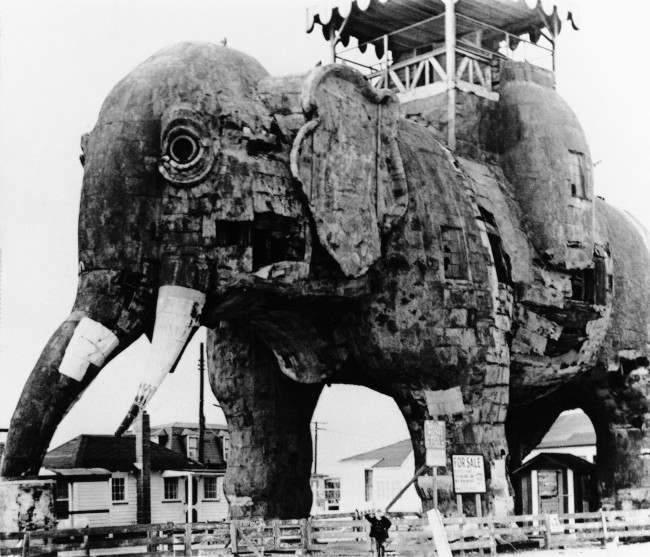
Lucy, the 88-year-old elephant who is a city landmark, will be restored and converted into a children’s library, if Margate residents get their way in Margate, New Jersey on Jan. 23, 1970. The Save Lucy Committee is in the throes of a campaign to raise money to move Lucy onto city property from the privately-owned site which is up for sale, and then beautify her. Lucy dwarfs admirer Stacey Kroger, 5. (AP Photo)
Pathe News was there to showcase Albarn’s mental adventure:
Albarn did not stop there. As he tells us, he got better. In Girvan, a seaside town in Carrick, South Ayrshire, he created the Fifth Dimension, another psychedelic, fibreglass fun house.
As it says on his website Patterns & Design:
“The Fifth Dimension”, a fun palace built on the edge of the beach at Girvan on the west coast of Scotland in 1969. A modular G.R.P. building of some 800 m2 , designed to entertain and disorientate the visitor.
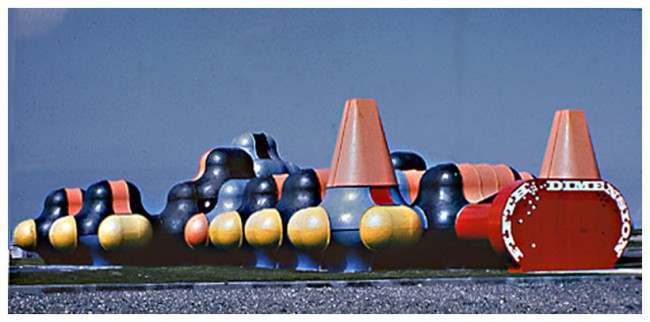
Come one, come all. In September 1970, Design magazine paid it a visit:
Strobe lights and hanging objects in the dark, hectic colours in patterns and shapes that fight the form, sudden spatial contrasts, eerie lights and an assortment of noises from murmurings to mindmelting screechings are old tricks – but they still work when used with all-round intelligence, as here. The warren of cells and tunnels and sudden loftier chambers presents at least half-a-dozen respectable visual excitements, as, for instance, when the almost subliminal strobe light (black and silver) of one cell slows down and takes on colour in the next.
The ”feelie” element is nowhere as sophisticated as this (near the entrance, for example, you find yourself bound to struggle – and it is a struggle – through a dense forest of heavy hanging objects) although further in there is a pitch-black vault with a teetering floor, where the barrel walls’ all repetitive domes and angles like a Camargo relief, invite finger exploration for just as long as the ears will stand a hideous electronic crescendo.The loftiest chamber, white and luminous, might have come straight from the set of Doctor Who with its do-it-yourself switchboard to alter lights and sounds. Finally another dark tunnel with fairy lights snaking endlessly away to the right (mirrors) leads you through a structure of translucent cubic boxes of coloured plastics sheets, ambigious and rather beautiful in a fairy castle kind of way. Then the boxes solidify, become white and gleaming in what you realise is not electricity now, but sunshine.
A good two shillings worth (children half price) of anyone’s money, wet day or fine.
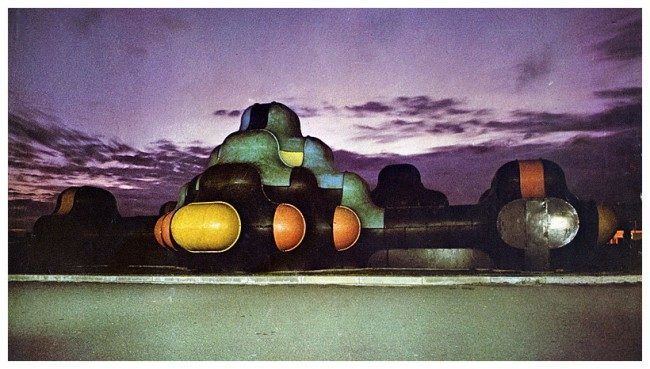
The fun house featured in the 1969 edition of Design Journal.
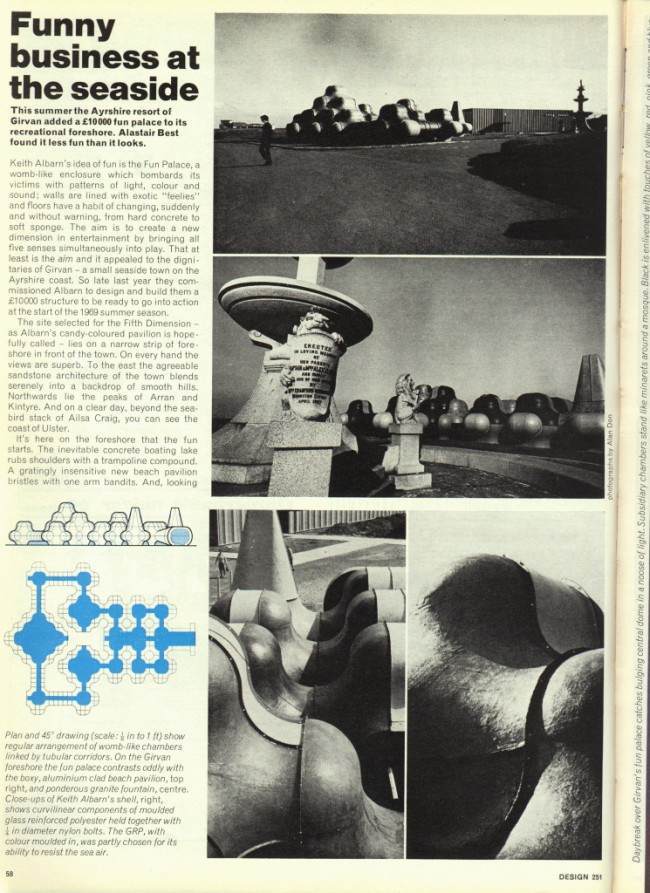
Visual Arts Data ServiceThe has transcribed the story:
Author: Alastair Best
Funny business at the seaside
This summer the Ayrshire resort of Girvan added a £10000 fun palace to its recreational foreshore. Alastair Best found it less fun than it looks.
Keith Albarn’s idea of fun is the Fun Palace, a womb-like enclosure which bombards its victims with patterns of light, colour and sound; walls are lined with exotic “feelies” and floors have a habit of changing, suddenly and without warning, from hard concrete to soft sponge. The aim is to create a new dimension in entertainment by bringing all five senses simultaneously into play. That a least is the aim and it appealed to the dignitaries of Girvan – a small seaside town on the Ayrshire coast. So late last year they commissioned Albarn to design and build them ~ £10000 structure to be ready to go into action at the start of the l969 summer season.
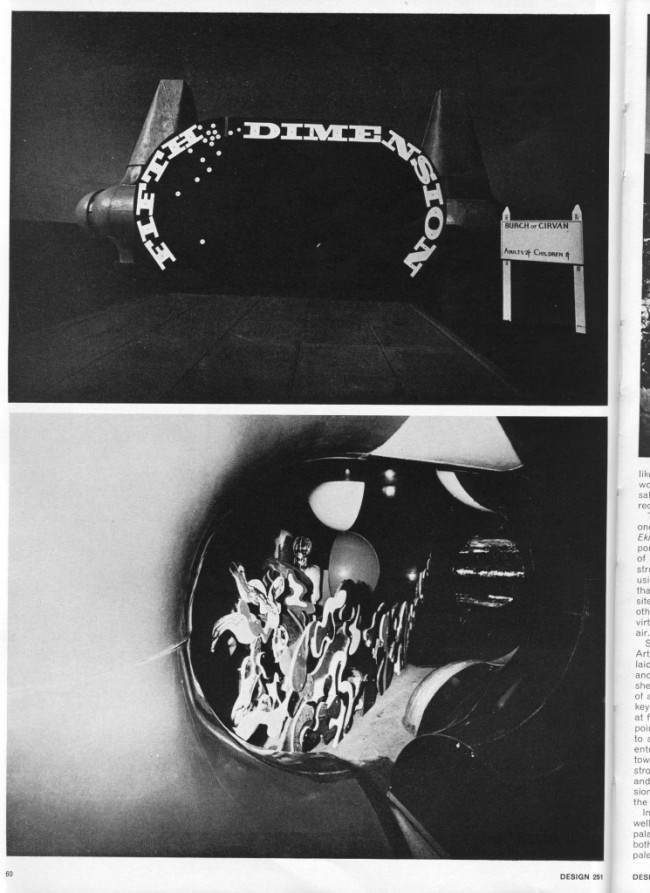
The site selected for the Fifth Dimension as Albarn’s candy-coloured pavilion is hope” fully called – lies on a narrow strip of foreshore in front of the town. On every hand the views are superb. To the east the agreeable sandstone architecture of the town blends serenely into a backdrop of smooth hills. Northwards lie the peaks of Arran and Kintyre. And on a clear day, beyond the sea bird stack of Ailsa Craig, you can see the coast of Ulster.
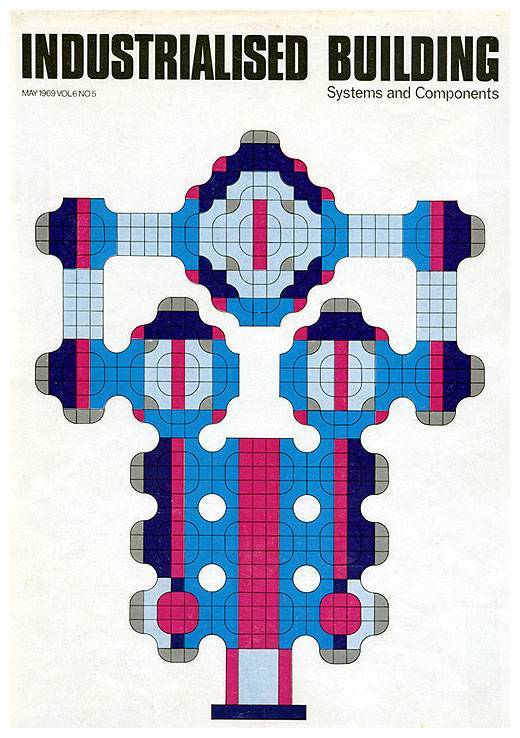
It’s here on the foreshore that the fun starts. The inevitable concrete boating lake rubs shoulders with a trampoline compound. A gratingly insensitive new beach pavilion bristles with one arm bandits. And, looking like a good deed in a naughty municipal world, sits the black, blue, yellow, red and salmon pink fun palace – Girvan’s new recreational toy.
Plan and 45ø drawing (scale. 1/8 in to 1 ft) show regular arrangement of womb-like chambers linked by tubular corridors. On the Girvan foreshore the fun palace contrasts oddly with the boxy, aluminium clad beach pavilion, top right, and ponderous granite fountain, centre. Close-ups of Keith Albarn’s shell, right, shows curvilinear components of moulded glass reinforced polyester held together with 1/4in diameter nylon bolts. The GRP, with colour moulded in, was partly chosen for its ability to resist the sea air.
The Fifth Dimension is that rare thing – the one-off industrialised building. Albarn’s Ekistikit system of curvilinear GRP components, made from a multi-purpose mould of his own design, has been used to construct the shell. “The chief advantages of using Ekistikit at Girvan,” says Albarn “are that the system is very easy to assemble on site – the units are simply joined to each other with 4 in nylon bolts – and GRP is virtually impervious to corrosion from the sea air.”
Shell units were moulded in Surrey by Artech Plastics Engineering who used hand laid up GRP made from Pilkington fibreglass and Scott Bader Crystic polyester resin. The shell covers an area of 5000 sq ft and consists of a series of 17 domed chambers linked by key-hole shaped corridors 6 ft high 2 ft wide at floor level and 6 ft wide at their broadest point. The sequence of chambers builds up to a large 20 ft high central dome and the entrance is flanked by two 14 ft orange towers. The use of colour on the exterior, with strong black accents, is particularly pleasing. and both in scale and shape the Fifth Dimension is by far the most promising structure on the Girvan foreshore.
Inside however, things do not go quite so well. The two essential ingredients of the fun palace concept – surprise and mystery – are both missing. Daylight Filters through the pale coloured walls of the shell to reveal a none too impressive array of kinetic hardware. Strobes wink feebly onto crudely assembled sheets of corrugated Perspex; textured floor and wall surfaces are easily detected, and come as no surprise; and electronic music, which we expect to hear played at a deafening pitch, merely rumbles ineffectively in the background. Alice, had she been let loose here, might have remarked that it all got less and less curious as you went along.
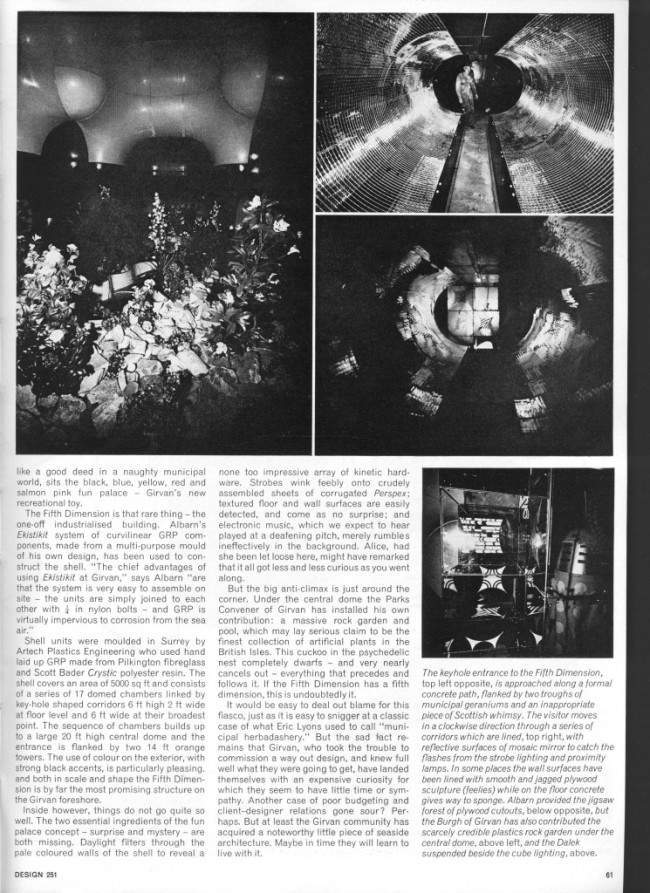
But the big anti-climax is just around the corner. Under the central dome the Parks Convener of Girvan has installed his own contribution: a massive rock garden and pool, which may lay serious claim to be the finest collection of artificial plants in the British Isles. This cuckoo in the psychedelic nest completely dwarfs – and very nearly cancels out – everything that precedes and follows it. If the Fifth Dimension has a Fifth dimension, this is undoubtedly it.
It would be easy to deal out blame for this fiasco, just as it is easy to snigger at a classic case of what Eric Lyons used to call “municipal herbadashery.” But the sad fact remains that Girvan, who took the trouble to commission a way out design, and knew full well what they were going to get, have landed themselves with an expensive curiosity for which they seem to have little time or sympathy. Another case of poor budgeting and client-designer relations gone sour? Perhaps. But at least the Girvan community has acquired a noteworthy little piece of seaside architecture. Maybe in time they will learn to live with it.
The keyhole entrance to the Fifth Dimension, top left opposite, is approached along a formal concrete path, flanked by two troughs of municipal geraniums and an inappropriate piece of Scottish whimsy. The visitor moves in a clockwise direction through a series of corridors which are lined, top right, with reflective surfaces of mosaic mirror to catch the flashes from the strobe lighting and proximity lamps. In some places the wall surfaces have been lined with smooth and jagged plywood sculpture (feelies) while on the floor concrete gives way to sponge. Albarn provided the jigsaw forest of plywood cutouts, below opposite, but the Burgh of Girvan has a/so contributed the scarcely credible plastics rock garden under the central dome, above left, and the Dalek suspended beside the cube lighting, above.
Was it all trippy and far out, not in the least bit realistic? Was it all impractical nuttiness, suited only for the Teletubbies and their Ninky Nog flying home?
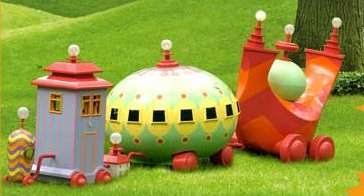
No. In the September 1970 issue of Design magazine, Albarn’s work was again profiled. His pods were being used to sell homes and the dream of modern living in Hertfordshire.
In Come into the garden city, José Manser went to a new town where the bucolic would blend seamlessly with the urban:
To attract customers for their new housing neighbourhoods in rural Letchworth, Wates have mounted a stylish, on-the-spot exhibition. Jose Manser reports; photographs by Tony Evans
Wates build houses – as well as being highly reputable contractors, package dealers and civil engineers – and their estates. pleasantly landscaped, well built and architecturally innocuous, cover considerable middle class tracts of southern England. Although they have rarely aimed at the minute avant-garde market which was entirely cornered by the now defunct Span, their business shrewdness is a byword, and they spotted the pulling power of dramatic, unconventional exhibition and selling centres in the middle of perfectly conventional suburban estates. The people came to see: the locals first. attracted by an intriguing structure, then their friends, and so on. They start looking at the display inside the centre. then drift out to the houses themselves. and so a purchase is made. A soft sell indeed, but a perfectly valid one, and in the process Wates have twice proved themselves design patrons of a rare and sympathetic nature.
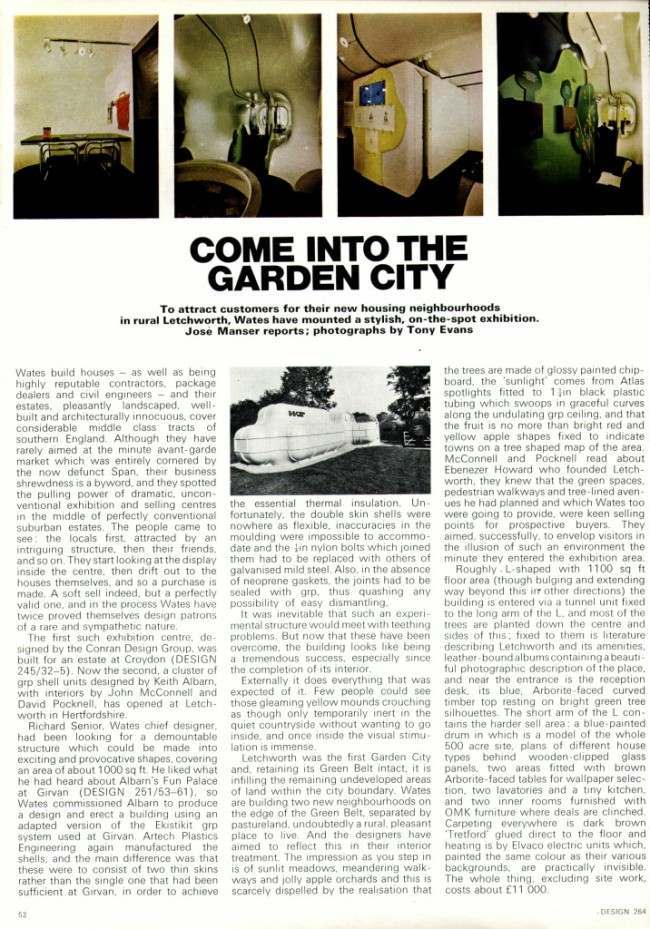
The first such exhibition centre, designed by the Conran Design Group, was built for an estate at Croydon (DESIGN 245/32-5). Now the second, a cluster of grp shell units designed by Keith Albarn, with interiors by John McConnell and David Pocknell, has opened at Letchworth in Hertfordshire.
Richard Senior, Wates chief designer, had been looking for a Remountable structure which could be made into exciting and provocative shapes, covering an area of about 1000 sq ft. He liked what he had heard about Albarn’s Fun Palace at Girvan (DESIGN 251/53-61), so Wates commissioned Albarn to produce a design and erect a building using an adapted version of the Ekistikit grp system used at Girvan. Artech Plastics Engineering again manufactured the shells, and the main difference was that these were to consist of two thin skins rather than the single one that had been sufficient at Girvan, in order to achieve the essential thermal insulation. Unfortunately, the double skin shells were nowhere as flexible, inaccuracies in the moulding were impossible to accommodate and the tin nylon bolts which joined them had to be replaced with others of galvanised mild steel. Also, in the absence of neoprene gaskets, the joints had to be sealed with grp, thus quashing any possibility of easy dismantling.
It was inevitable that such an experimental structure would meet with teething problems. But now that these have been overcome, the building looks like being a tremendous success, especially since the completion of its interior.
Externally it does everything that was expected of it. Few people could see those gleaming yellow mounds crouching as though only temporarily inert in the quiet countryside without wanting to go inside, and once inside the visual stimulation is immense.
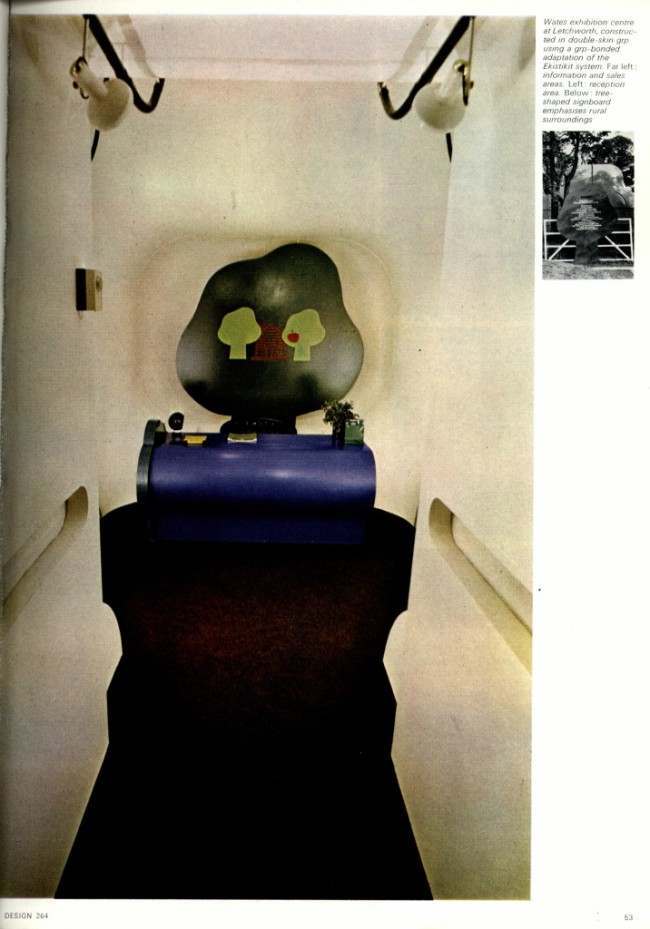
Letchworth was the first Garden City and, retaining its Green Belt intact, it is infilling the remaining undeveloped areas of land within the city boundary. Wates are building two new neighbourhoods on the edge of the Green Belt, separated by pastureland, undoubtedly a rural, pleasant place to live. And the designers have aimed to reflect this in their interior treatment. The impression as you step in is of sunlit meadows, meandering walkways and jolly apple orchards and this is scarcely dispelled by the realisation that the trees are made of glossy painted chipboard, the ‘sunlight’ comes from Atlas spotlights fitted to 1’in black plastic tubing which swoops in graceful curves along the undulating grp ceiling, and that the fruit is no more than bright red and yellow apple shapes fixed to indicate towns on a tree shaped map of the area. McConnell and Pocknell read about Ebenezer Howard who founded Letchworth, they knew that the green spaces, pedestrian walkways and tree-lined avenues he had planned and which Wates too were going to provide, were keen selling points for prospective buyers. They aimed, successfully, to envelop visitors in the illusion of such an environment the minute they entered the exhibition area.
Roughly. L-shaped with 1100 sq ft floor area (though bulging and extending way beyond this ire other directions) the building is entered via a tunnel unit fixed to the long arm of the L, and most of the trees are planted down the centre and sides of this; fixed to them is literature describing Letchworth and its amenities, leather-bound albums containing a beautiful photographic description of the place, and near the entrance is the reception desk, its blue. Arborite-faced curved timber top resting on bright green tree silhouettes. The short arm of the L contains the harder sell area: a blue-painted drum in which is a model of the whole 500 acre site, plans of different house types behind wooden-clipped glass panels, two areas fitted with brown Arborite-faced tables for wallpaper selection, two lavatories and a tiny kitchen, and two inner rooms furnished with OMK furniture where deals are clinched. Carpeting everywhere is dark brown ‘Tretford’ glued direct to the floor and heating is by Elvaco electric units which, painted the same colour as their various backgrounds, are practically invisible. The whole thing, excluding site work, costs about
£11000.
Sadly, nothing remains of it now. More’s the pity.
Would you like to support Flashbak?
Please consider making a donation to our site. We don't want to rely on ads to bring you the best of visual culture. You can also support us by signing up to our Mailing List. And you can also follow us on Facebook, Instagram and Twitter. For great art and culture delivered to your door, visit our shop.

